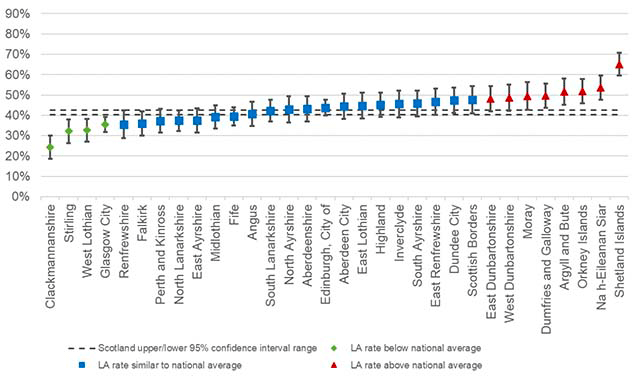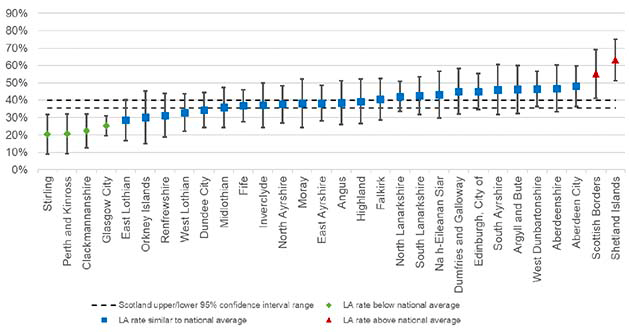Scottish House Condition Survey: Local Authority Analysis 2017-2019
Local Authority figures for 2017-2019, including fuel poverty rates, energy efficiency ratings, the condition of housing and the Scottish Housing Quality Standard.
This document is part of a collection
Scottish Housing Quality Standard (SHQS)
The SHQS is a common standard for assessing the condition of Scotland's social sector housing. However, as the SHCS collects data on all tenures, the data can be compared across the housing stock although private owners and landlords are currently under no obligation to bring their properties up to this standard. Dwellings are assessed on 55 different elements – which are broken into five broader criteria. Failure of one of these criteria results in an outright SHQS fail – the criteria themselves can be failed in many cases on a single element. A full list of SHQS criteria is available on the SHQS website. The SHCS tests compliance with 54 of the 55 elements.
In the period 2017-2019, an average of 41% of dwellings in Scotland failed the SHQS (Figure 12). Clackmannanshire (24%), Stirling (32%), West Lothian (33%) and Glasgow City (35%) had failure rates lower than the Scottish average. Eight local authorities had failure rates higher than the Scotland average, with the highest being Shetland Islands (65%), Na h-Eileanan Siar (54%), Orkney Islands (52%) and Argyll and Bute (52%).
Focusing on the social sector, the average national SHQS failure rate was 38% in the period 2017-2019 (Figure 13). Most local authorities had similar rates to the 2017-2019 social sector national average. However, Shetland Islands (63%) and Scottish Borders (55%) had higher failure rates than the national average, while social sector failure rates in Stirling (20%), Perth and Kinross (21%), Clackmannanshire (22%) and Glasgow City (25%) were below the national average. It should be noted that as the social sector sample size in the SHCS is smaller than all tenures overall (nationally 2,176 compared to 8,963 in the three year period), there are larger margins of error associated with social sector estimates (as seen comparing the confidence interval ranges in Figure 12 and Figure 13).
The most common criterion all local authorities failed on was around elements relating to energy efficiency. The next most common failures were generally on elements relating to the "Healthy, Safe and Secure" criterion, followed by those addressing the "Modern Facilities" criterion.
The Scottish Housing Regulator (SHR) is responsible for monitoring compliance of the social housing sector with the SHQS. There are some differences between the SHR and the SHCS in the way data for assessing the standard is collected and reported which make the headline rates not immediately comparable. Abeyances and exemptions are not taken into account by the SHCS as it is not feasible to collect this kind of information in the survey. In addition, despite the high quality of the physical survey, there are challenges in detecting the presence of cavity wall insulation in all cases. The SHCS Key Findings 2019 report found that if it is assumed that all dwellings have insulated cavity walls, the overall social sector SHQS failure rate would be 28% compared to 41% without this assumption in 2019. More information can be found in section 6.2 of the 2019 SHCS Key Findings.

Note: In this chart, the proportion of SHQS failures for Scotland as a whole is a three-year average. This is different to the proportion published in the main SHCS Key Findings report, which is an annual figure.

Note: In this chart, the proportion of social sector SHQS failures for Scotland as a whole is a three-year average. This is different to the proportion published in the main SHCS Key Findings report, which is an annual figure. East Renfrewshire and East Dunbartonshire are not shown due to small sample sizes.
Contact
Email: shcs@gov.scot
There is a problem
Thanks for your feedback